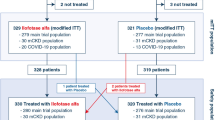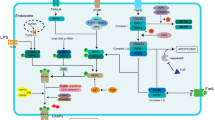Abstract
Inflammation is currently recognized as a key mechanism in the pathogenesis of renal ischemia–reperfusion (I/R) injury. The importance of infiltrating neutrophil, lymphocytes, and macrophage in this kind of injury has been assessed with conflicting results. Annexin 1 is a protein with potent neutrophil anti-migratory activity. In order to evaluate the effects of annexin A1 on renal I/R injury, uninephrectomized rats received annexin A1 mimetic peptide Ac2-26 (100 μg) or vehicle before 30 min of renal artery clamping and were compared to sham surgery animals. Annexin A1 mimetic peptide granted a remarkable protection against I/R injury, preventing glomerular filtration rate and urinary osmolality decreases and acute tubular necrosis development. Annexin A1 infusion aborted neutrophil extravasation and attenuated macrophage infiltration but did not prevent tissue lymphocyte traffic. I/R increased annexin A1 expression (assessed by transmission electron microscopy) in renal epithelial cells, which was attenuated by exogenous annexin A1 infusion. Additionally, annexin A1 reduced I/R injury in isolated proximal tubules suspension. Annexin A1 protein afforded striking functional and structural protection against renal I/R. These results point to an important role of annexin A1 in the epithelial cells defense against I/R injury and indicate that neutrophils are key mediators for the development of tissue injury after renal I/R. If these results were confirmed in clinical studies, annexin A1 might emerge as an important tool to protect against I/R injury in renal transplantation and in vascular surgery.







Similar content being viewed by others
References
Uchino S, Kellum JA, Bellomo R, Doig GS, Morimatsu H, Morgera S, Schetz M, Tan I, Bouman C, Macedo E et al (2005) Beginning and ending supportive therapy for the kidney (BEST Kidney) investigators. Acute renal failure in critically ill patients: a multinational, multicenter study. JAMA 294:813–818
Gwinner W, Hinzmann K, Erdbruegger U, Scheffner I, Broecker V, Vaske B, Kreipe H, Haller H, Schwarz A, Mengel M (2000) Acute tubular injury in protocol biopsies of renal grafts: prevalence, associated factors and effect on long-term function. Am J Transplant 8:1684–1693
Lu CY, Hartono J, Senitko M, Chen J (2007) The inflammatory response to ischemic acute kidney injury: a result of the ‘right stuff’ in the ‘wrong place’? Curr Opin Nephrol Hypertens 16:83–89
Bonventre JV (2007) Pathophysiology of acute kidney injury: roles of potential inhibitors of inflammation. Contrib Nephrol 156:39–46
Devarajan P (2006) Update on mechanisms of ischemic acute kidney injury. J Am Soc Nephrol 17:503–1520
Willinger CC, Schramek H, Pfaller K, Pfaller W (1992) Tissue distribution of neutrophils in postischemic acute renal failure. Virchows Arch B Cell Pathol Incl Mol Pathol 62:237–243
Koo DD, Welsh KI, Roake JA, Morris PJ, Fuggle SV (1998) Ischemia/reperfusion injury in human kidney transplantation: an immunohistochemical analysis of changes after reperfusion. Am J Pathol 153:557–566
Ysebaert DK, De Greef KE, Vercauteren SR, Ghielli M, Verpooten GA, Eyskens EJ, De Broe ME (2000) Identification and kinetics of leukocytes after severe ischaemia/reperfusion renal injury. Nephrol Dial Transplant 15:1562–1574
Friedewald JJ, Rabb H (2004) Inflammatory cells in ischemic acute renal failure. Kidney Int 66:486–491
Singbartl K, Ley K (2004) Leukocyte recruitment and acute renal failure. J Mol Med 82:91–101
Riera M, Torras J, Herrero I, Valles J, Paubert-Braquet M, Cruzado JM, Alsina J, Grinyo JM (1997) Neutrophils accentuate renal cold ischemia–reperfusion injury. Dose-dependent protective effect of a platelet-activating factor receptor antagonist. J Pharmacol Exp Ther 280:786–794
Park P, Haas M, Cunningham PN, Bao L, Alexander JJ, Quigg RJ (2002) Injury in renal ischemia–reperfusion is independent from immunoglobulins and T lymphocytes. Am J Physiol Renal Physiol 282:F352–F357
Rabb H, Daniels F, O’Donnell M, Haq M, Saba SR, Keane W, Tang WW (2000) Pathophysiological role of T lymphocytes in renal ischemia–reperfusion injury in mice. Am J Physiol Renal Physiol 279:F525–F531
Jo SK, Sung SA, Cho WY, Go KJ, Kim HK (2006) Macrophages contribute to the initiation of ischaemic acute renal failure in rats. Nephrol Dial Transplant 21:1231–1239
Rabb H (2006) Immune modulation of acute kidney injury. J Am Soc Nephrol 17:604–606
Huang Y, Rabb H, Womer KL (2007) Ischemia–reperfusion and immediate T cell responses. Cell Immunol 248:4–11
Perretti M, Flower RJ (2004) Annexin 1 and the biology of the neutrophil. J Leukoc Biol 76:25–29
Oliani SM, Christian HC, Manston J, Flower RJ, Perretti M (2000) An immunocytochemical and in situ hybridization analysis of annexin 1 expression in rat mast cells: modulation by inflammation and dexamethasone. Lab Invest 80:1429–1438
Oliani SM, Paul-Clark MJ, Christian H, Flower RJ, Perretti M (2001) Neutrophil interaction with inflamed post-capillary venule endothelium alters annexin 1 expression. Am J Phatol 158:603–615
Kamal AM, Flower RJ, Perretti M (2005) An overview of the effects of annexin 1 on cells involved in the inflammatory process. Mem Inst Oswaldo Cruz 100(Suppl 1):39–47
Cuzzocrea S, Tailor A, Zingarelli B, Salzman AL, Flower RJ, Szabó C, Perretti M (1997) Lipocortin 1 protects against splanchnic artery occlusion and reperfusion injury by affecting neutrophil migration. J Immunol 159:5089–5097
D’Amico M, Di Filippo C, La M, Solito E, McLean PG, Flower RJ, Oliani SM, Perretti M (2000) Lipocortin 1 reduces myocardial ischemia–reperfusion injury by affecting local leukocyte recruitment. FASEB J 14:1867–1869
La M, D’Amico M, Bandiera S, Di Filippo C, Oliani SM, Gavins FN, Flower RJ, Perretti M (2001) Annexin 1 peptides protect against experimental myocardial ischemia–reperfusion: analysis of their mechanism of action. FASEB J 15:2247–2256
Gavins FN, Dalli J, Flower RJ, Granger DN, Perretti M (2007) Activation of the annexin 1 counter-regulatory circuit affords protection in the mouse brain microcirculation. FASEB J 21:1751–1758
Teoh NC, Ito Y, Field J, Bethea NW, Amr D, McCuskey MK, McCuskey RS, Farrell GC, Allison AC (2007) Diannexin, a novel annexin V homodimer, provides prolonged protection against hepatic ischemia–reperfusion injury in mice. Gastroenterology 133:632–646
Shen XD, Ke B, Zhai Y, Tsuchihashi SI, Gao F, Duarte S, Coito A, Busuttil RW, Allison AC, Kupiec-Weglinski JW (2007) Diannexin, a novel annexin V homodimer, protects rat liver transplants against cold ischemia–reperfusion injury. Am J Transplant 7:2463–2471
Ahluwalia A, Buckingham JC, Croxtall JD, Flower RJ, Goulding NJ, Perretti M (1996) Biology of annexin 1. In: Seaton BA (ed) Annexins: molecular structure to cellular function. Landes, Austin, pp 161–199
Gerke V, Creutz CE, Moss SE (2005) Annexins: linking Ca2+ signalling to membrane dynamics. Nat Rev Mol Cell Biol 6:449–461
Solito E, Kamal A, Russo-Marie F, Buckingham JC, Marullo S, Perretti M (2003) A novel calcium-dependent proapoptotic effect of annexin 1 on human neutrophils. FASEB J 17:1544–1546
Mancuso F, Flower RJ, Perretti M (1995) Leukocyte transmigration, but not rolling or adhesion, is selectively inhibited by dexamethasone in the hamster post-capillary venule. Involvement of endogenous lipocortin 1. J Immunol 155:377–386
Lim LH, Solito E, Russo-Marie F, Flower RJ, Perretti M (1998) Promoting detachment of neutrophils adherent to murine postcapillary venules to control inflammation: effect of lipocortin 1. Proc Natl Acad Sci USA 95:14535–14539
Gavins FN, Yona S, Kamal AM, Flower RJ, Perretti M (2003) Leukocyte antiadhesive actions of annexin 1: ALXR- and FPR-related anti-inflammatory mechanisms. Blood 101:4140–4147
McKanna JA, Chuncharunee A, Munger KA, Breyer JA, Cohen S, Harris RC (1992) Localization of p35 (annexin I, lipocortin I) in normal adult rat kidney and during recovery from ischemia. J Cell Physiol 153:467–476
Soubhia RM, Mendes GE, Mendonça FZ, Baptista MA, Cipullo JP, Burdmann EA (2005) Tacrolimus and nonsteroidal anti-inflammatory drugs: an association to be avoided. Am J Nephrol 25:327–334
Yu L, Gengaro PE, Niederberger M, Burke TJ, Schrier RW (1994) Nitric oxide: a mediator in rat tubular hypoxia/reoxygenation injury. Proc Natl Acad Sci USA 91:1691–1695
Damazo AS, Yona S, Flower RJ, Perretti M, Oliani SM (2006) Spatial and temporal profiles for anti-inflammatory gene expression in leukocytes during a resolving model of peritonitis. J Immunol 176:4410–4418
Babbin BA, Parkos CA, Mandell KJ, Winfree LM, Laur O, Ivanov AI, Nusrat A (2007) Annexin 2 regulates intestinal epithelial cell spreading and wound closure through Rho-related signaling. Am J Pathol 170:951–966
Babbin BA, Laukoetter MG, Nava P, Koch S, Lee WY, Capaldo CT, Peatman E, Severson EA, Flower RJ, Perretti M, Parkos CA, Nusrat A (2008) Annexin A1 regulates intestinal mucosal injury, inflammation, and repair. J Immunol 181:5035–5544
McMahon B, Mitchell D, Shattock R, Martin F, Brady HR, Godson C (2002) Lipoxin, leukotriene, and PDGF receptors cross-talk to regulate mesangial cell proliferation. FASEB J 16:1817–1819
Bonventre JV, Zuk A (2004) Ischemic acute renal failure: an inflammatory disease? Kidney Int 66:480–485
Chatterjee BE, Yona S, Rosignoli G, Young RE, Nourshargh S, Flower RJ, Perretti M (2005) Annexin 1-deficient neutrophils exhibit enhanced transmigration in vivo and increased responsiveness in vitro. J Leukoc Biol 78:639–646
Paller MS (1989) Effect of neutrophil depletion on ischemic renal injury in the rat. J Lab Clin Med 113:379–386
Vries B, Köhl J, Leclercq WK, Wolfs TG, van Bijnen AA, Heeringa P, Buurman WA (2003) Complement factor C5a mediates renal ischemia–reperfusion injury independent from neutrophils. J Immunol 170:3883–3889
Linas SL, Shanley PF, Whittenburg D, Berger E, Repine JE (1988) Neutrophils accentuate ischemia–reperfusion injury in isolated perfused rat kidneys. Am J Physiol 255:F728–F735
Kelly KJ, Williams WW Jr, Colvin RB, Meehan SM, Springer TA, Gutierrez-Ramos JC, Bonventre JV (1996) Intercellular adhesion molecule-1-deficient mice are protected against ischemic renal injury. J Clin Invest 97:1056–1063
Perretti M, Gavins FNE (2003) Annexin 1: an endogenous anti-inflammatory protein. News Physiol Sci 18:60–64
Kielar ML, John R, Bennett M, Richardson JA, Shelton JM, Chen L, Jeyarajah DR, Zhou XJ, Zhou H, Chiquett B et al (2005) Maladaptive role of IL-6 in ischemic acute renal failure. J Am Soc Nephrol 16:3315–3325
Day YJ, Huang L, Ye H, Linden J, Okusa MD (2005) Renal ischemia–reperfusion injury and adenosine 2A receptor-mediated tissue protection: role of macrophages. Am J Physiol Renal Physiol 288:F722–F731
Ko GJ, Boo CS, Jo SK, Cho WY, Kim HK (2008) Macrophages contribute to the development of renal fibrosis following ischaemia/reperfusion-induced acute kidney injury. Nephrol Dial Transplant 23:842–852
Vinuesa E, Hotter G, Jung M, Herrero-Fresneda I, Torras J, Sola A (2008) Macrophage involvement in the kidney repair phase after ischaemia/reperfusion injury. J Pathol 214:104–113
Suleiman M, Cury PM, Pestana JO, Burdmann EA, Bueno V (2005) FTY720 prevents renal T-cell infiltration after ischemia/reperfusion injury. Transplant Proc 37:373–374
Faubel S, Ljubanovic D, Poole B, Dursun B, He Z, Cushing S, Somerset H, Gill RG, Edelstein CL (2005) Peripheral CD4 T-cell depletion is not sufficient to prevent ischemic acute renal failure. Transplantation 80:643–649
Yokota N, Burne-Taney M, Racusen L, Rabb H (2003) Contrasting roles for STAT4 and STAT6 signal transduction pathways in murine renal ischemia–reperfusion injury. Am J Physiol Renal Physiol 285:F319–F325
Donnahoo KK, Meng X, Ayala A, Cain MP, Harken AH, Meldrum DR (1999) Early kidney TNF-alpha expression mediates neutrophil infiltration and injury after renal ischemia–reperfusion. Am J Physiol 277:R922–R929
Acknowledgments
EA Burdmann and S. M. Oliani are partially supported by grants from Foundation for the Support of Research in the State of São Paulo (Fundação de Amparo à Pesquisa do Estado de São Paulo) and from the National Council for Scientific and Technological Development (Conselho Nacional de Desenvolvimento Científico e Tecnológico, process 307371/2006-9 and 306074/2007-9, respectively). The authors are grateful to Livia C. Burdmann for the excellent grammar review of the manuscript.
Conflicts of interest
The authors have no competing financial interests to disclose in relation to this manuscript.
Author information
Authors and Affiliations
Corresponding authors
Additional information
Emmanuel A. Burdmann and Sonia Maria Oliani share senior authorship of this manuscript.
Rights and permissions
About this article
Cite this article
Facio, F.N., Sena, A.A., Araújo, L.P. et al. Annexin 1 mimetic peptide protects against renal ischemia/reperfusion injury in rats. J Mol Med 89, 51–63 (2011). https://doi.org/10.1007/s00109-010-0684-4
Received:
Revised:
Accepted:
Published:
Issue Date:
DOI: https://doi.org/10.1007/s00109-010-0684-4




